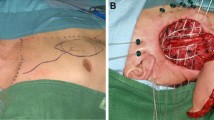Purpose:
To report the therapeutic results obtained with CT-guided interstitial high-dose-rate brachytherapy (HDR-BRT) as exclusive treatment for recurrent neck metastases of head-and-neck tumors.
Patients and Methods:
Between 1995 and 1999, 49 patients with prior radiation therapy (RT) with or without surgery for primary head-and-neck tumors were treated for recurrent neck metastases located within previously irradiated volumes. All patients had fixed lymphadenopathy with a mean tumor volume of 96 cm3 (range, 15–452 cm3). There were 38 males and eleven females with a mean age of 60 years (range, 28–79 years). All patients had previously received RT as primary or adjuvant treatment with a mean dose of 54 Gy (range, 45–80 Gy). 36 patients (73%) underwent surgery, and 26 (53%) received adjuvant or palliative chemotherapy. The accelerated hyperfractionated interstitial HDR-BRT (2 × 3.0 Gy/day) delivered 30 Gy in 37/49 (75%) and 36 Gy in 12/49 implants (25%).
Results:
At a minimum 6-week follow-up, the response rate was 83% (41/49) with complete remission in 20% (10/49) and partial remission in 63% (31/49) of the implanted tumor sites. 8/49 patients (17%) did not respond to the treatment. After 19 months of median follow-up, the local control rate was 69% and a total of 15/49 patients (30%) experienced local disease progression. Of these, nine (18%) had locoregional progression and six (12%) progression within the treated volume. The median post-BRT survival was 14 months. The overall survival rate was 52% at 1 year, 31% at 2 years, and 6% at 3 years.
Conclusion:
In patients with recurrent cervical lymphadenopathy of head-and-neck tumors, exclusive interstitial HDR-BRT can provide palliation and tumor control.
Ziel:
Vorstellung der CT-gestützten interstitiellen High-Dose-Rate-Brachytherapie (HDR-BRT) als ausschließliches Therapieverfahren in der Behandlung zervikaler Lymphknotenrezidive von Kopf-Hals-Tumoren.
Patienten und Methodik:
Zwischen 1995 und 1999 wurden insgesamt 49 Patienten mit zervikalen Lymphknotenrezidiven behandelt. Alle 49 Patienten (38 männlich, elf weiblich, Durchschnittsalter 60 Jahre [28–79 Jahre]) waren mit einer durchschnittlichen Zielvolumendosis von 54 Gy (45–80 Gy) vorbestrahlt, und 36 (73%) waren voroperiert. Eine adjuvante oder palliative Chemotherapie war bei 26 Patienten (53%) durchgeführt worden. Alle Patienten erhielten eine akzeleriert-hyperfraktionierte BRT (2 × 3 Gy/Tag) bis zu einer Gesamtdosis von 30 Gy in 37/49 (75%) und 36 Gy in 12/49 Implantaten (25%). Das durchschnittliche Tumorvolumen betrug 96 cm3 (15–452 cm3).
Ergebnisse:
Die Ansprechrate nach 6 Wochen betrug 83%. Bei 10/49 Patienten (20%) wurde eine komplette Remission, bei 31/49 (63%) eine partielle Remission erzielt. 8/49 (17%) zeigten kein Ansprechen bzw. eine lokale Progredienz. Nach einer medianen Nachbeobachtungszeit von 19 Monaten betrug die lokale Kontrollrate 69%, bei 15/49 Patienten (30%) lag ein Tumorprogress vor. Dabei zeigten 9/15 (60%) eine lokoregionäre Progression. Lediglich bei 6/15 (40%) handelte es sich um echte In-loco-Rezidive, die innerhalb des BRT-Volumens gelegen waren. Das mediane Überleben betrug 14 Monate, die Gesamtüberlebensrate nach 1 Jahr 52%, nach 2 Jahren 31% und nach 3 Jahren 6%.
Schlussfolgerung:
Die CT-gestützte interstitielle HDR-BRT ist ein wertvolles Instrument für die palliative Behandlung von Patienten mit Halslymphknotenrezidiven bei Kopf-Hals-Tumoren.
Similar content being viewed by others
Author information
Authors and Affiliations
Corresponding author
Rights and permissions
About this article
Cite this article
Kolotas, C., Tselis, N., Sommerlad, M. et al. Reirradiation for Recurrent Neck Metastases of Head-and-Neck Tumors Using CT-Guided Interstitial 192Ir HDR Brachytherapy. Strahlenther Onkol 183, 69–75 (2007). https://doi.org/10.1007/s00066-007-1632-2
Received:
Revised:
Issue Date:
DOI: https://doi.org/10.1007/s00066-007-1632-2




